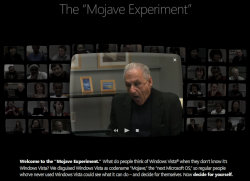The "Mojave Experiment" - Just an exercise in guided clicking or does it highlight some of the problems with Windows Vista

Microsoft has today unveiled the "Mojave Experiment." In case you haven't heard, this is an experiment where the company took 140 Vista skeptics (who hadn't used Vista themselves) and showed them what they believed to be a new Microsoft operating system, code-named Mojave. After the participants delivered their opinion of the "new" OS (which was almost exclusively positive) they were then told that Mojave was in fact Vista.

After the demo the participants rated Mojave an average of 8.5, with one actually saying "Wow" and another saying that the "The speed is incredible." When it is revealed to the participants that Mojave is in fact Windows Vista, the most common reply seems to be "really?" Also, at least one participant does figure out that he's being shown Vista and not some top secret new OS.
Note: The test rig that was used was a HP Pavilion DV2500 loaded with running an Intel Core 2 Duo CPU T7500 @ 2.20GHz, 2GB of RAM and 32 bit version of Windows Vista Ultimate.
Now, on the face of it it's easy to dismiss the Mojave Experiment as little more than marketing hyperbole. After all, I've been to plenty of demos given by trained staff that made a product look fantastic, only to later have hands on time with that product and find out that it sucked whole lemons. That's what trained salespeople do. Also, this seemed like a guided clicking session where people are told clearly what they should be doing or paying attention to. It's not like these folks were given a copy of "Mojave" and told to install it, or left to their own devices while they set up a printer or configured a network. These people were watching Vista, not using it. Also, Microsoft hasn't released unedited versions of the videos, so it's safe to say that the best bits have been picked.
But, it is interesting how no one reduced their score on being guided through Mojave/Vista, and maybe this tells us a little about what's wrong with Vista (or at least the impression that people have of the OS). See, these 140 participants were guided through what I assume were Vista's highlights, and this helped boost the average rating by 4.1 points in 10 minutes. When you get your hands on Vista for the first time there's usually no one there to guide you through the OS, showing you the new games, the photo preview feature, what the Sidebar can do, how to make DVD, how to use the Flip 3D feature, how Instant Search works, how to set up Media Center, what's new in Administrative Tools or anything and everything else. You're on your own. As operating systems become more complicated and have more features, it's easy for the best features to be hidden from view, and sometimes all that's needed is a helping had to bring those features out into the open. I can think of one ad campaign that does this, and in my opinion does it well - the ads for the Apple iPhone.
It's possible that part of Microsoft's mistake with Vista (apart from allowing OEMs to install it on sub-standard hardware) was to make Aero the main selling point and overlook the features that users might have actually found useful. Eye-candy isn't really a feature. I doubt that Microsoft will make the same mistake next time.
Thoughts?